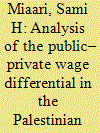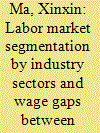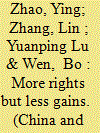|
|
|
Sort Order |
|
|
|
Items / Page
|
|
|
|
|
|
|
| Srl | Item |
| 1 |
ID:
171074


|
|
|
|
|
| Summary/Abstract |
This paper measures and analyzes the dynamics of the public–private wage differential in the West Bank and Gaza for the period before and during the ‘second Intifada’ using data from the Palestinian Labour Force Survey (PLFS) of the Palestinian Central Bureau of Statistics (PCBS). Because the distribution of workers’ individual characteristics, such as skills, and the ‘returns’ to these characteristics may differ across workers, the wage differential is decomposed into two components: an ‘endowment’ effect and a ‘returns’ effect. The results show that in the pre-Intifada period, the wage gap between the public and private sectors narrowed in both the West Bank and Gaza. However, a sharp increase is seen after the outbreak of the Intifada. Moreover, most of this increase comes from an increase in ‘returns’ to skills composition in the public sector, (unexplained effect), rather than a change in the skills composition of public sector workers, (explained effect). Using recent econometric quantile regression techniques, the analysis of the public–private sector wage gap from 1998 to 2006, at various points along the wage distribution, shows that the wage premium, (penalty), for the public sector varies across the distribution, being higher, (lower), at the lowest end of the wage distribution and decreasing (increasing) along the wage distribution; it becomes negative in the top percentiles.
|
|
|
|
|
|
|
|
|
|
|
|
|
|
|
|
| 2 |
ID:
098344


|
|
|
|
|
| Publication |
2010.
|
| Summary/Abstract |
Using a panel of cross sections, this study measures wage differentials between Israeli-Arab and Jewish workers between 1991 and 2003. The wage gap is then decomposed into components corresponding to human capital, occupational segregation, selectivity, and a residual (unexplained gap). The study shows large fluctuations in the wage gap, almost doubling in the last decade, reaching 75% in 1999. Because sudden changes in the underlying characteristics of the populations are not likely, a large part of the level and changes in the wage gap were captured by the residual - possibly one of the implications of the ongoing Israeli-Palestinian conflict.
|
|
|
|
|
|
|
|
|
|
|
|
|
|
|
|
| 3 |
ID:
161770


|
|
|
|
|
| Summary/Abstract |
This paper explores the influence of labor market segmentation by industry sectors on the wage gap between rural-to-urban migrants and local urban residents in China in the 2000s. Using Chinese Household Income Project (CHIP) survey data and the results based on the Brown decomposition method, the results indicate that the influence of intra-industrial differentials is greater than the influence of inter-industry differentials in both 2002 and 2013. The influence of the explained component of the intra-industry differentials is larger in both 2002 and 2013, and the influence of the unexplained component of the intra-industrial differentials rises steeply from 2002 to 2013. These results show that the individual characteristic differentials (e.g. human capital) in the same industry sector is the main factor causing the wage gap in both 2002 and 2013, and the problem of discrimination against migrants in the same industry sector became more serious from 2002 to 2013.
|
|
|
|
|
|
|
|
|
|
|
|
|
|
|
|
| 4 |
ID:
175504


|
|
|
|
|
| Summary/Abstract |
This paper studies the gender wage differential in the Palestinian labor market of the West Bank before, during, and in the aftermath of the second Intifada. We combine data on the Palestinian labor force, politically motivated fatalities of Palestinians, and movement restrictions in the West Bank, in order to quantify the effect of political violence on the gender wage gap. We find that political violence during the second Intifada decreased the gender wage gap. We also observe a long-term trend of more women entering the labor force, especially in middle-income occupations where there is an existing large share of female employees. Political violence did not seem to reverse or hurt that trend. We provide suggestive evidence that the reduction in the wage gap is due to the increased supply of low-skilled men, who previously worked in Israel and entered the local labor market due to the Intifada.
|
|
|
|
|
|
|
|
|
|
|
|
|
|
|
|
| 5 |
ID:
191156


|
|
|
|
|
| Summary/Abstract |
In view of its aging population, China initiated in 2012 a relaxed birth control policy after a three-decades-long implementation of the restrictive one-child policy. This paper examines how China's relaxed birth control policy leads to gender inequality. It specifically focuses on migrant workers because they account for a significant portion of the working group. Using the National Migrant Population Dynamic Monitoring Survey from 2014 to 2016, we found that China's two-child pilot policy reduced female labor force participation by 1.4 percentage points. This negative effect was more pronounced for women with higher educational levels or working in the private sector because employers foresee greater risks of productivity decline. We demonstrated that the gender pay gap increased from RMB956 to RMB1,053 during this same period. Pinpointing these unintended consequences brought about by the relaxation of the one-child policy helps provide a more complete picture of inequality and make sense of persistent relative poverty in Chinese society. To counteract gender discrimination, females are advised to work outside their home jurisdictions and take advantage of positive peer effects.
|
|
|
|
|
|
|
|
|
|
|
|
|
|
|
|
| 6 |
ID:
181228


|
|
|
|
|
| Summary/Abstract |
Using the Mincer equation and the Oaxaca decomposition, this article examines what part of the gender wage gap in Israel during the years 2005–16 can be explained by differences in demographic attributes and preferences of men and women and what part cannot be explained by these variables, hence indicates gender discrimination. Findings show that during the examined period, there was no systematic change in the unexplained wage gap. However, in the years 2017–18, the unexplained wage gap between men and women began to decrease.
|
|
|
|
|
|
|
|
|
|
|
|
|
|
|
|
|
|
|
|
|